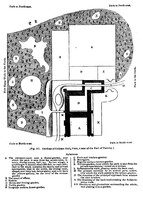THE fruit or kitchen-garden, as it is generally cultivated, is little better than a ploughed field, where crops are sown in drills; for this reason, it has frequently, by Brown, and always by his followers, been banished to a distance, where it might no longer be an unsightly object. I have occasionally found gardens so placed, at two miles from the house, and, consequently, the choice fruits are removed with as much care and trouble, in the package and conveyance, as if they came from Brentford to Covent Garden market* [I have noticed this error in the extract from the Report of Woburn Abbey.]. What I have to insert in this Fragment is not the result of any single report, but is collected from various hints, thrown out at different places, for the rational improvement of a useful garden, shewing how it may be rendered ornamental; for, though I have elsewhere asserted that a ferme orne is a solecism in language, yet a jardin orne may be made one of the most interesting luxuries of a country residence: and this may be effected in various ways; the most simple, and that which I have successfully adopted in several villas near London, has been to surround with a border of shrubs and flowers, three or four areas of different dimensions, from an eighth to three-quarters of an acre of garden ground; to raise crops of fruit and vegetables, perfectly hid from the lawn and walks by the surrounding screen of flowering shrubs and evergreens; which, in some cases, will even hide dwarf walls, and pits and frames for forcing early fruits. By this means, the lawn of pleasure-ground may be varied in its shapes, and the quantity of mowing curtailed: and, if we choose to view the interior of the masses which serve to diversify the landscape, we find new objects to amuse the eye or gratify the taste, at the time those fruits are ripe, which are most delicious when gathered by our own hands. The interior fence of these patches may be of holly, roses, gooseberries, or barberries; serving to increase the mass of screen, and to protect the produce of the garden. This may be perfectly applicable to places on a small scale; but, in large establishments, where one garden of several acres may be preferred, that garden should, if possible, be contiguous to the mansion, and a wood, or screen of shrubs, should envelop the whole, as it is described on the map of Cobham Hall [fig. 161, p. 420].

